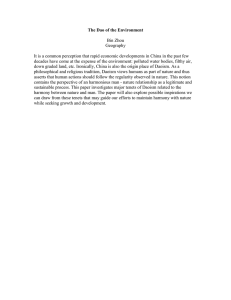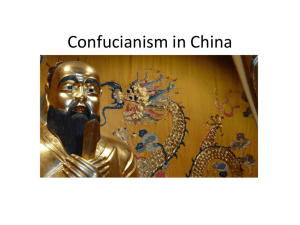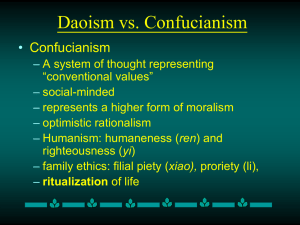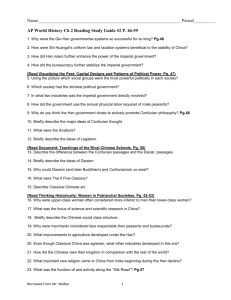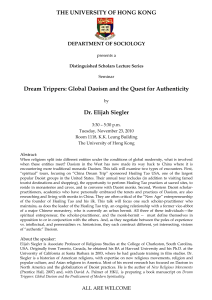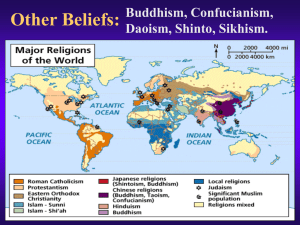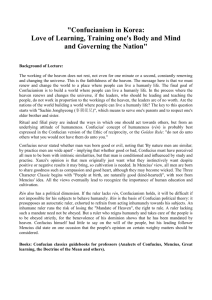SACRED PLACE, SACRED SPACE: East Asia
advertisement
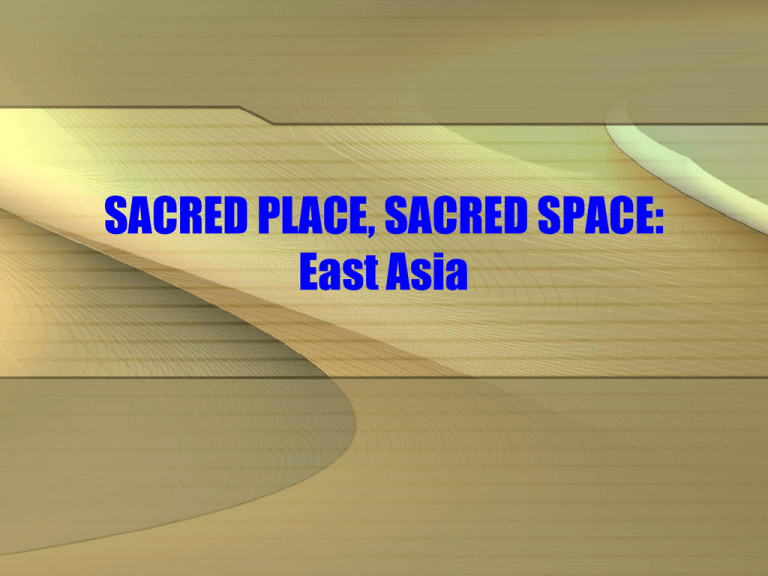
SACRED PLACE, SACRED SPACE: East Asia SHINTO • Absolute Location – Japan • Tribal Religion becomes Traditional • Tribal Beliefs or Shrine Shinto • • • • • • The world is kami or spirit (kami-kaze or divine wind) Localized kami or spirits of specific areas Some kami represent processes, larger natural objects The world is transcendent; placate, venerate nature No aspect of personal salvation; no concept of sin Thousands of shrines throughout Japan localize belief • • • • • • • Chinese cultural traditions arrive and traditional Shinto emerges Veneration of nature, ancestral spirits; some anthropomorphism Shaman become priests; no literature or holy books Ceremonies celebrate passages of life, seasons Rituals of cleanliness, blessings Shinto becomes a nationalist tradition honoring emperor Emperor is the descendent of the sun-goddess • Traditional or Sect Shinto • Syncretism: Has blended with Buddhism, Confucianism IMAGES OF SHINTO THE KOJIKI, c. 680 CE • “Hereupon all the Heavenly Deities commanded the two Deities His Augustness the Male-Who-Invites and Her Augustness the Female-Who-Invites, ordering them to "make, consolidate, and give birth to this drifting land." Granting to them an heavenly jeweled spear, they [thus] deigned to charge them. So the two Deities, standing upon the Floating Bridge of Heaven, pushed down the jeweled spear and stirred with it, whereupon, when they had stiffed the brine till it went curdle-curdle, and drew [the spear] up, the brine that dripped down from the end of the spear was piled up and became an island. This is the Island of Onogoro.” DAOISM Prominent critics of Confucianism Preferred philosophical reflection and introspection Understand natural principles, live in harmony with them Laozi and Zhuangzi Laozi, founder of Daoism; wrote the Daodejing Zhuangzi, Daoist philosopher, wrote Zhuangzi Philosophical Daoism Dao - The way of nature, the way of the cosmos Opposites in balance, complementary An eternal principle governing all workings of the world Passive, yielding, does nothing , accomplishes everything Tailor behavior to passive, yielding nature Ambition, activism brought the world to chaos Popular Daoism A folk or religious form of Daoism; not philosophical Emerged at end of Han Dynasty Seek to master forces of natural, spiritual world Many deities including immortals, which people venerated Symbolized prosperity, happiness Many saints were patrons of certain occupations Gods associated with natural cycles, agriculture Daoist priests were shamans, performed exorcisms DAOIST WUWEI The doctrine of wuwei Disengagement from worldly affairs Called for simple, unpretentious life Live in harmony with nature Advocated small state, self-sufficient community Political implications Served as a counterbalance to Confucian activism Individuals often both Confucians and Daoists Flourishes when society at peace, prosperous DAOIST SYMBOLS Direction Element Symbol / Constellation Season Force East Wood Azure Dragon Spring Yang South Fire Vermilion Bird Summer Yang West Metal White Tiger Autumn Yin North Water Black Tortoise Winter Yin Center Earth none none Neutral THE DAO TE CHING, CHAPTER 39 • The things which from of old have got the One (the Tâo) are-Heaven which by it is bright and pure; Earth rendered thereby firm and sure; Spirits with powers by it supplied; Valleys kept full throughout their void All creatures which through it do live Princes and kings who from it get The model which to all they give. All these are the results of the One (Tâo). If heaven were not thus pure, it soon would rend; If earth were not thus sure, 'twould break and bend; Without these powers, the spirits soon would fail; If not so filled, the drought would parch each vale; Without that life, creatures would pass away; Princes and kings, without that moral sway, However grand and high, would all decay. SACRED SITES OF DAOISM Legend (1) Home of Lao Tze (2) Tao Te Ching revealed at Mt. Chung-nan Shan (3) Founding of the Celestial Masters (4) Mao shan (5) Dragon and Tiger Mountain (6) Taoist pilgrimage site CHINESE POPULAR RELIGION Customary beliefs and practice As old as civilization in China Never encouraged/discouraged by state Syncretic in nature Will absorb many different traditions Blends all major ideas, philosophies Exists in harmony with official philosophies, faiths Believes gods, spirits (shen) influence family, world Power over world affairs Deceased members of community, family Deified figures of history, literature Spiritual embodiment of nature, geography Maintenance of family shrines, community temples Prayers, supplications Food offerings Shamanism and divination are practiced HOUSEHOLD & PUBLIC RITUALS Household Rituals Always performed by males Expression of Confucian filial piety Domestic altar Names of deceased, icons Worship of the stove god Oversees family’s moral conduct Reports on family to heaven Public Rituals Preserve social harmony, local identity Local earth god protects area from spirits City god important; has temple at center of city Physical, public processions, offerings Supreme Deity and Influence of Daoism Shangdi (Ruler on High) Cannot be addressed directly Shang kings called up other spirits to address Shangdi Later called Tian or Heaven Rulers called Son of Heaven Empire is his favorite government Mandate of Heaven is an off-shoot of this idea CONFUCIUS’ SEARCH FOR ORDER Confucius (551-479 B.C.E.) A strong-willed man, from an aristocratic family Traveled ten years searching for an official post Educator with numerous disciples Sayings compiled in the Analects by disciples Fundamentally moral and ethical in character Restore political and social order; stress ritual Formation of junzi - "superior individuals" Edited Zhou classics for his disciples to study Ren - a sense of humanity Li - a sense of propriety Xiao - filial piety Cultivating of junzi for bringing order to China 5 Relationships and filial piety as basis of society Confucian ideas The key Confucian concepts CONFUCIAN SOCIAL HIERARCHY Confucian Scholar Official CONFUCIUS AND MENCIUS SAY: "The greenery on Niu Mountain was once beautiful, but since it was near a large city, it was attacked by lumberjacks. How could it retain its beauty? Still, by breathing in the sunlight and rain, how could new buds and sprouts not appear? But then cattle and sheep came and fed themselves, and by the time they were done, it was completely barren. If people saw this barrenness, they might have imagined that there had never been any greenery. How could the mountain be inherently like this? In the case of people, how could they lack the mind of Humanity and Righteousness? But the daily damaging of the goodness of their mind is just like the lumberjacks on the mountain. Being chopped down day after day, how can it manifest its natural beauty? One may breathe in fresh air day and night, but if you allow the enjoyment of evil doings with people to close in on you, the air gets thin, and your daytime activities stifle you. Because of this stifling, the fresh air is insufficient. Being insufficient, your goodness of mind is not nourished, and there will be little difference between you and the animals. People see our animalistic nature and assume that we have never had great endowments. How could this be our real nature? Therefore, if it is properly nourished, there is nothing that will not grow. If it is not nourished, there is nothing that will not die. Confucius said: 'Use it and you will keep it; ignore it and you will lose it. “ SACRED SITES OF CONFUCIANISM (1) Ch'u-fu (Qufu)--Confucius's= birthplace, a pilgrimage site; (2) Beijing – site of the Temple of Heaven, location of Imperial ceremonies performed on behalf of the nation; (3) Beijing – location of T'ien-an Men Square (4) Mt. T'ai and Mt. Wu-T'ai—holy mountains valued by all three major religions of China; sites where officials offered prayers on behalf of the people; (5) Korea (6) Japan BEIJING: THE FORBIDDEN CITY THEME: LOCATION THE CONFUCIAN CITY AS A MODEL OF THE UNIVERISE LEGALISM IN PRACTICE The state's strength Agriculture Military force Discouraged commerce, education, and the arts How to treat people Harnessing self-interest of people for needs of state Called “carrot and stick” approach in west Called for harsh penalties even for minor infractions Advocated collective responsibility before law Not popular among the Chinese, Chinese used legalism if state threatened Legalism still doctrine common to China
